ATmospheric LIDar (ATLID): Pre-Launch Testing and Calibration of the European Space Agency Instrument That Will Measure Aerosols and Thin Clouds in the Atmosphere
Abstract
1. Introduction: The EarthCARE mission
- Observation of the vertical profiles of natural and anthropogenic aerosols on a global scale, their radiative properties and interaction with clouds;
- Observation of the vertical distributions of atmospheric liquid water and ice on a global scale, their transport by clouds and their radiative impact;
- Observation of cloud distribution (‘cloud overlap’), cloud precipitation interactions and the characteristics of vertical motions within clouds;
- Retrieval of profiles of atmospheric radiative heating and cooling through the combination of the retrieved aerosol and cloud properties.
2. ATLID Measurement Principle
3. ATLID Instrument Design
4. ATLID Performance Test Overview
4.1. Performance Verification Approach
4.2. Receiver Measurement Setup
- Generated by a frequency-tripled, Nd:YAG, narrow-band Optical Ground Support Equipment (OGSE), UV laser (source-pack outside the vacuum chamber), which is fibre-coupled;
- Through part B of OGSE FPA (OGSE multi-purpose focal plane assembly, outside the vacuum chamber, detailed in Figure 6), which allows for laser beam parameters adjustment, including polarisation, line-of-sight and radiometric level, and then free path;
- Through OGSE collimator COL70 (70 cm diameter, inside the vacuum chamber); up to ATLID telescope input.
4.3. Transmitter Measurement Setup
- (1)
- Laser pulse energy;
- (2)
- Laser beam divergence.
5. Test Results
5.1. Transmitter Test Results
5.1.1. Laser Pulse Energy
5.1.2. Laser Beam Divergence
5.2. Radiometric Tests
- Polarisation
- Field-Of-View
- Radiometric stability
- Dark current
5.2.1. ATLID Receiver Polarisation Characterisation
- Scans of the OGSE laser wavelength are performed, for vertical and horizontal linear polarisation directions, and the channels’ relative responses are extracted;
- Rotations of the OGSE beam linear polarisation orientation are performed, for OGSE source-pack laser wavelength set at HSRE response peak, and the channels’ relative responses are extracted.
5.2.2. ATLID Field-of-View Characterisation
5.2.3. ATLID Radiometric Stability Characterisation
5.2.4. ATLID Dark Current Characterisation
6. ATLID Performance Update and Flight Prediction Overview
6.1. Performance Analysis
6.2. Performance Summary
- a sub visible cirrus: faint cirrus at the limit of instrument detection, β = 8 × 10−7 sr−1 m−1
- a thin cirrus: β = 1.4 × 10−5sr−1m−1
- a depolarisation cirrus: cirrus with 10% depolarisation ratio, βpar = 2.6 × 10−5 sr−1 m−1 and βper = 2.6 × 10−6 sr−1 m−1
7. ATLID Verification Closure and Lessons Learnt
8. Conclusions
Author Contributions
Funding
Institutional Review Board Statement
Informed Consent Statement
Data Availability Statement
Acknowledgments
Conflicts of Interest
References
- EarthCARE—Clouds, Aerosols and Radiation Explorer. Available online: http://esamultimedia.esa.int/docs/SP_1279_1_EarthCARE.pdf (accessed on 5 January 2021).
- Lefebvre, A.; Hélière, A.; Albiñana, A.P.; Wallace, K.; Maeusli, D.; Lemanczyk, J.; Lusteau, C.; Nakatsuka, H.; Tomita, E. EarthCARE mission, overview, implementation approach and development status. In Earth Observing Missions and Sensors: Development, Implementation, and Characterization IV; International Society for Optics and Photonics: Bellingham, WA, USA, 2016; Volume 9881. [Google Scholar]
- Hélière, A.; Wallace, K.; Carmo, J.P.D.; Lefebvre, A. Earth Cloud, Aerosol and Radiation Explorer optical payload development status. In Sensors, Systems, and Next-Generation Satellites XXI; International Society for Optics and Photonics: Bellingham, WA, USA, 2017; Volume 10423. [Google Scholar]
- Lefebvre, A. EarthCARE mission: Approaching launch. In Proceedings of the IEEE International Geoscience and Remote Sensing Symposium (IGARSS) 2018, Valencia, Spain, 23–27 July 2018. [Google Scholar]
- Wehr, T.; Eisinger, M.; Koopman, R.; Lefebvre, A.; Maeusli, D.; Wallace, K.; Pereira Do Carmo, J.; Livschitz, J.; Maksym, S. Status of ESA’s EarthCARE Mission Preparation. In Proceedings of the IEEE International Geoscience and Remote Sensing Symposium (IGARSS) 2020, Waikoloa, HI, USA, 19–24 July 2020. [Google Scholar]
- Illingworth, A.J.; Barker, H.W.; Beljaars, A.; Ceccaldi, M.; Chepfer, H.; Clerbaux, N.; Cole, J.; Delanoë, J.; Domenech, C.; Donovan, D.P.; et al. The EarthCARE Satellite: The Next Step Forward in Global Measurements of Clouds, Aerosols, Precipitation, and Radiation. Bull. Am. Meteorol. Soc. 2015, 1311–1322. [Google Scholar] [CrossRef]
- Hélière, A.; Wallace, K.; Carmo, J.P.D.; Lefebvre, A.; Eisinger, M.; Wehr, T. A Development status of the EarthCARE Mission and its atmospheric Lidar. In Earth Observing Systems XXI; International Society for Optics and Photonics: Bellingham, WA, USA, 2016; Volume 9972. [Google Scholar]
- Carmo, J.P.D.; Chassat, F.; Hélière, A.; Toulemont, Y.; Lefevre, A. ATLID, ESA atmospheric lidar: Manufacture and test results of instrument units. In Proceedings of the International Conference on Space Optics (ICSO) 2016, Biarritz, France, 18–21 October 2016. [Google Scholar]
- De Villele, G.; Carmo, J.P.D.; Helière, A.; Lefebvre, A.; Barbaro, L.; Belhadj, T.; Chassat, F.; Corselle, B.; Evin, R.; Feral, M.; et al. ATLID, ESA Atmospheric LIDAR: Integration of instrument and tests. In Proceedings of the International Conference on Space Optics (ICSO) 2018, Chania, Greece, 9–12 October 2018. [Google Scholar]
- Carmo, J.P.D.; De Villele, G.; Helière, A.; Wallace, K.; Lefebvre, A.; Chassat, F. ATLID, ESA Atmospheric backscatter LIDAR for the ESA EarthCARE Mission. Counc. Eur. Aerosp. Soc. CEAS Space J. 2019, 11, 423–435. [Google Scholar] [CrossRef]
- Pereira do Carmo, J.; Wallace, K.; Lefebvre, A. Flight LIDAR development and qualification for the ESA Earth Cloud Aerosol and radiation explorer (EarthCARE) mission. In Proceedings of the IEEE International Geoscience and Remote Sensing Symposium (IGARSS) 2020, Waikoloa, HI, USA, 19–24 July 2020. [Google Scholar]
- Wallace, K.; Hélière, A.; Lefebvre, A.; Eisinger, M.; Wehr, T. Status of ESA’s EarthCARE mission, passive instruments payload, In Earth Observing Systems XXI; International Society for Optics and Photonics: Bellingham, WA, USA, 2016; Volume 9972. [Google Scholar]
- Tomiyama, N.; Tomita, E.; Furukawa, K.; Nakatsuka, H.; Seki, Y.; Aida, Y.; Okada, K.; Maruyama, K.; Ishii, Y.; Ohno, Y.; et al. EarthCARE/CPR development status and performance. In Remote Sesning of Clouds and Atmosphere XXV; International Society for Optics and Photonics: Bellingham, WA, USA, 2020; Volume 11531. [Google Scholar]
- Domenech, C.; Donovan, D.P.; Barker, H.W.; Bouvet, M.; Lopez-Baeza, E. Improvement of broadband radiance to flux conversion by using the synergy between active and passive remote sensing instruments. In SPIE Remote Sensing, Florence, Italy; International Society for Optics and Photonics: Bellingham, WA, USA, 2007; Volume 6745. [Google Scholar]
- Straume, A.G.; Rennie, M.; Isaksen, L.; de Kloe, J.; Marseille, G.J.; Stoffelen, A.; Flament, T.; Stieglitz, H.; Dabas, A.; Huber, D.; et al. ESA’s space-based Doppler wind lidar mission Aeolus—First wind and aerosol product assessment results. In Proceedings of the EPJ Web Conference, Moscow, Russia, 16–20 November 2020. [Google Scholar] [CrossRef]
- Weiler, F.; Kanitz, T.; Wernham, D.; Rennie, M.; Huber, D.; Schillinger, M.; Saint-Pe, O.; Bell, R.; Parrinello, T.; Reitebuch, O. Characterisation of dark current measurements of the ACCDs used on-board Aeolus satellite. Atmos. Meas. Tech. Discuss. 2020. [Google Scholar] [CrossRef]
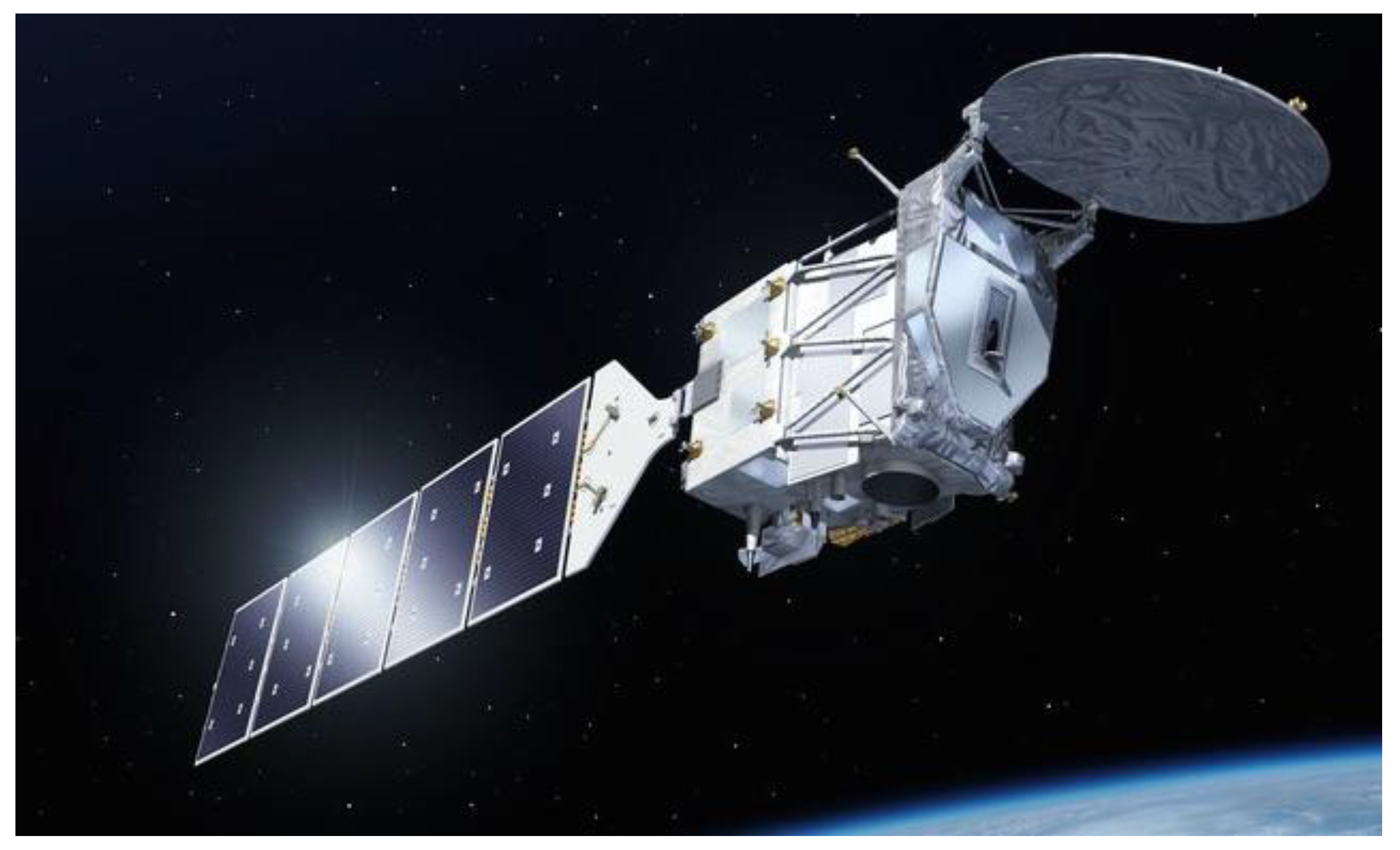

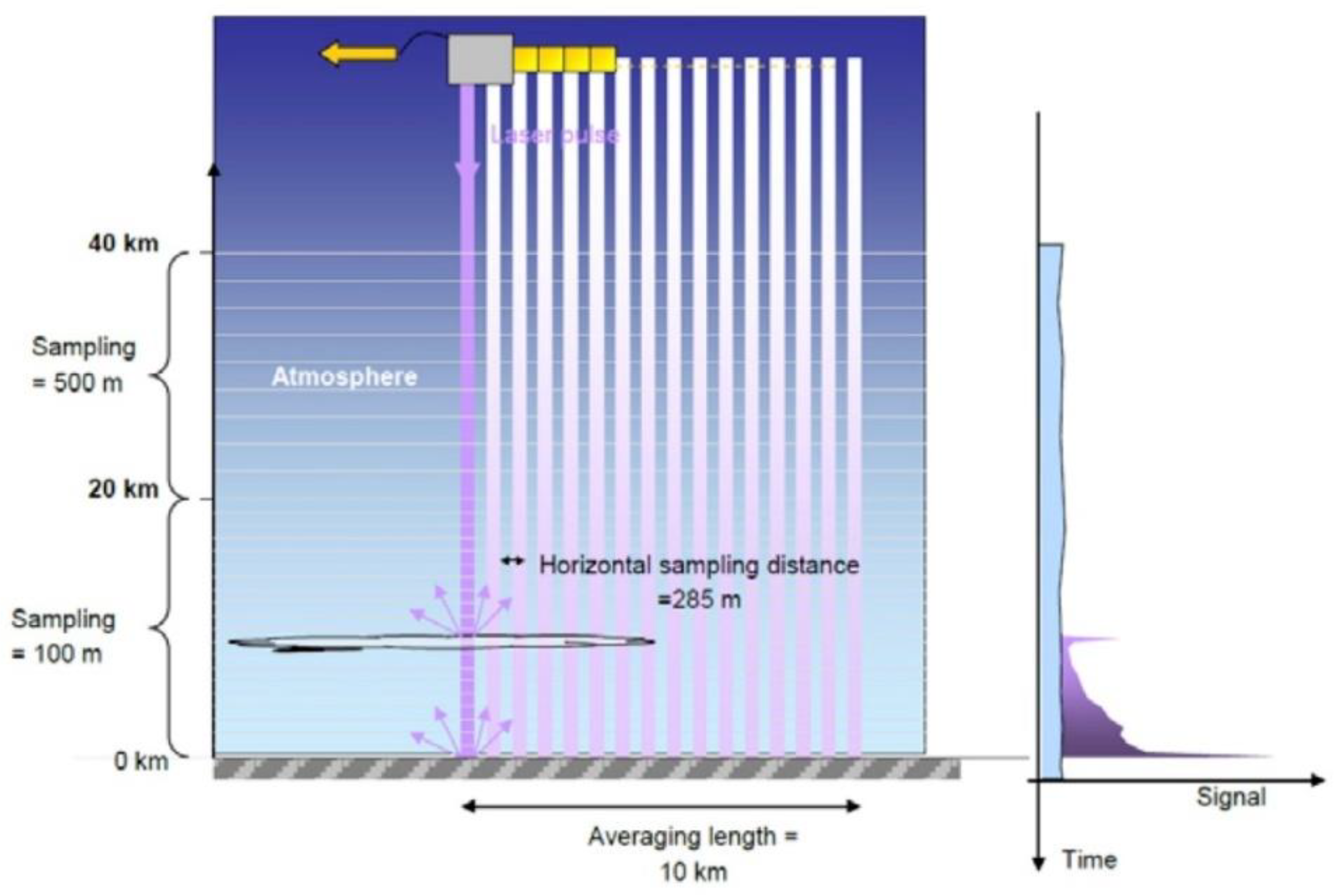

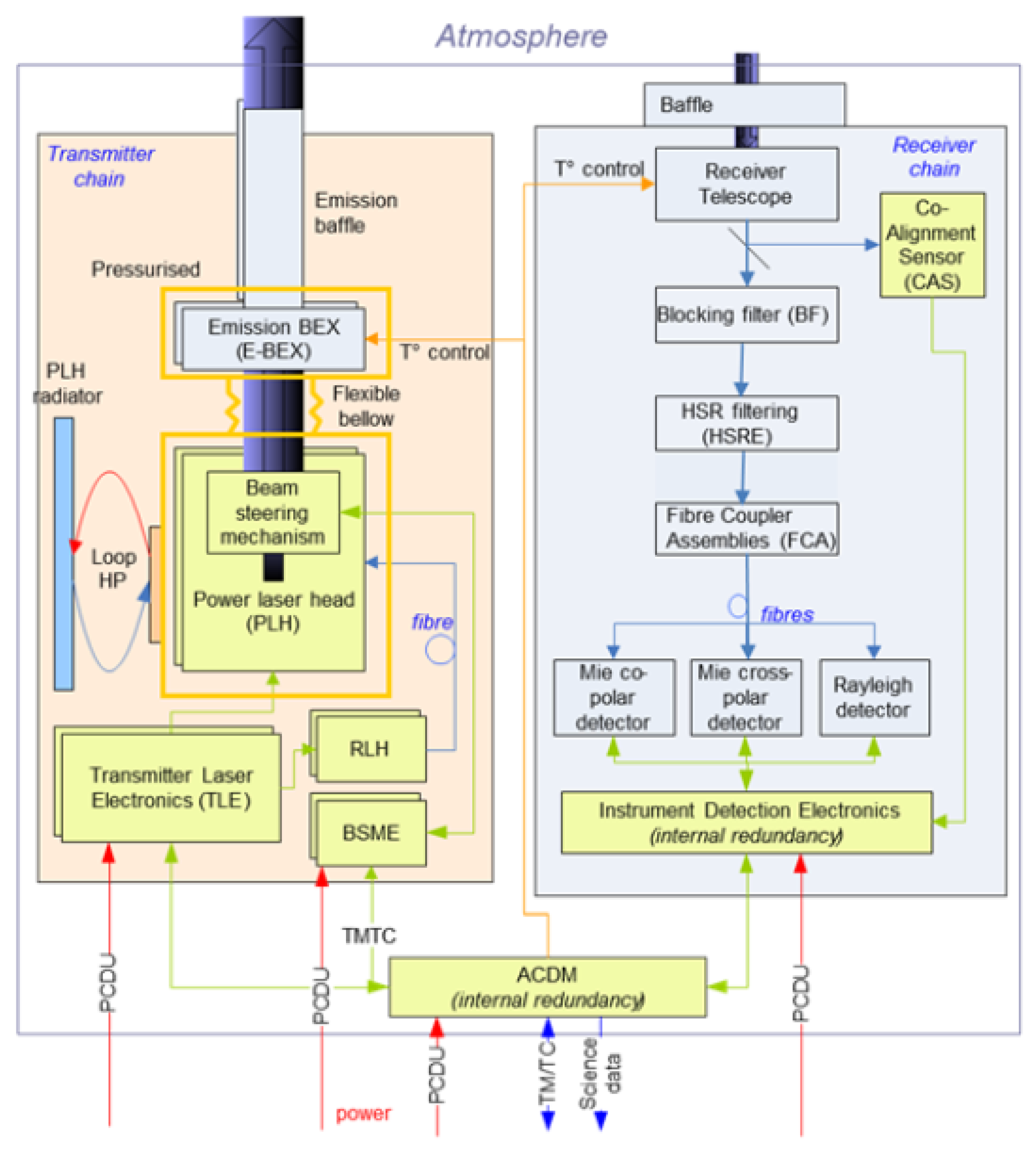

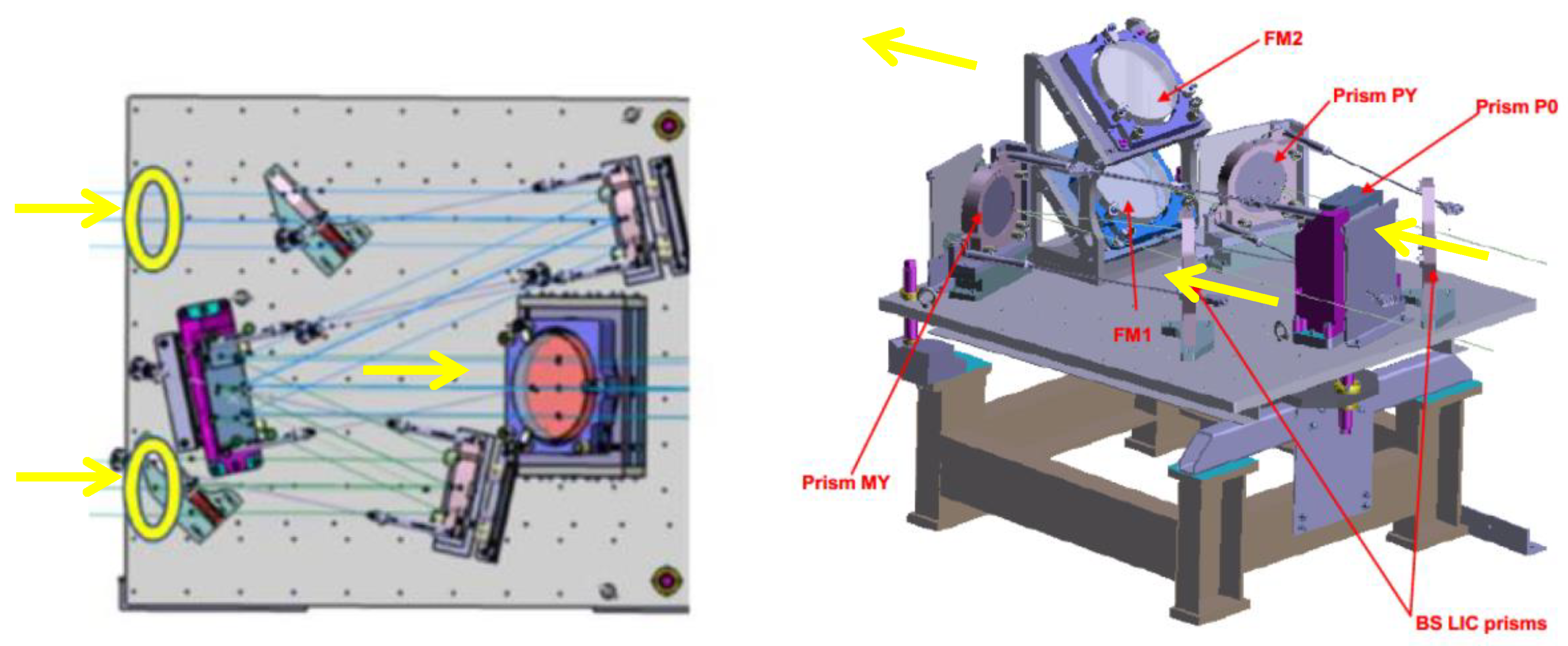

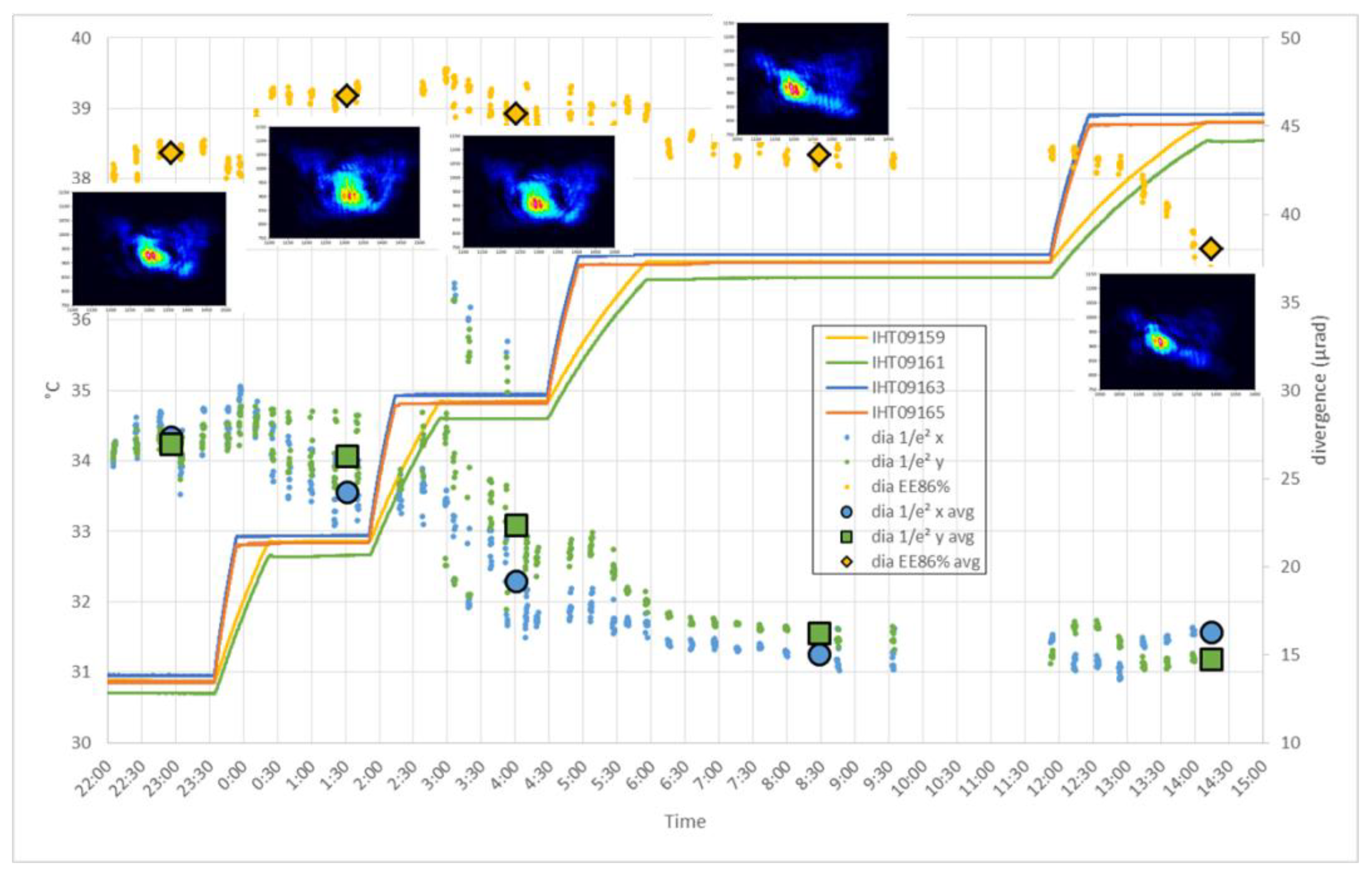
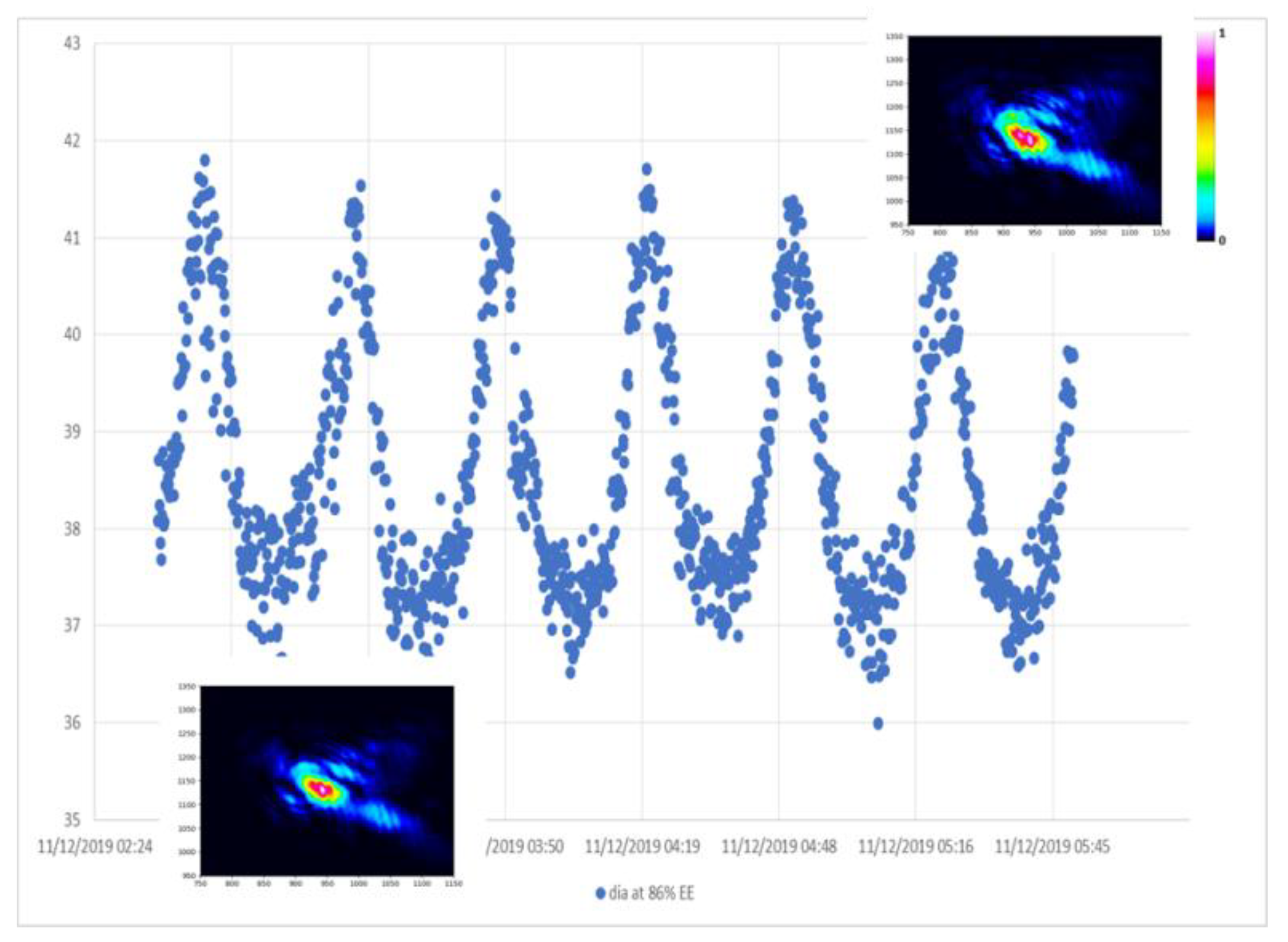

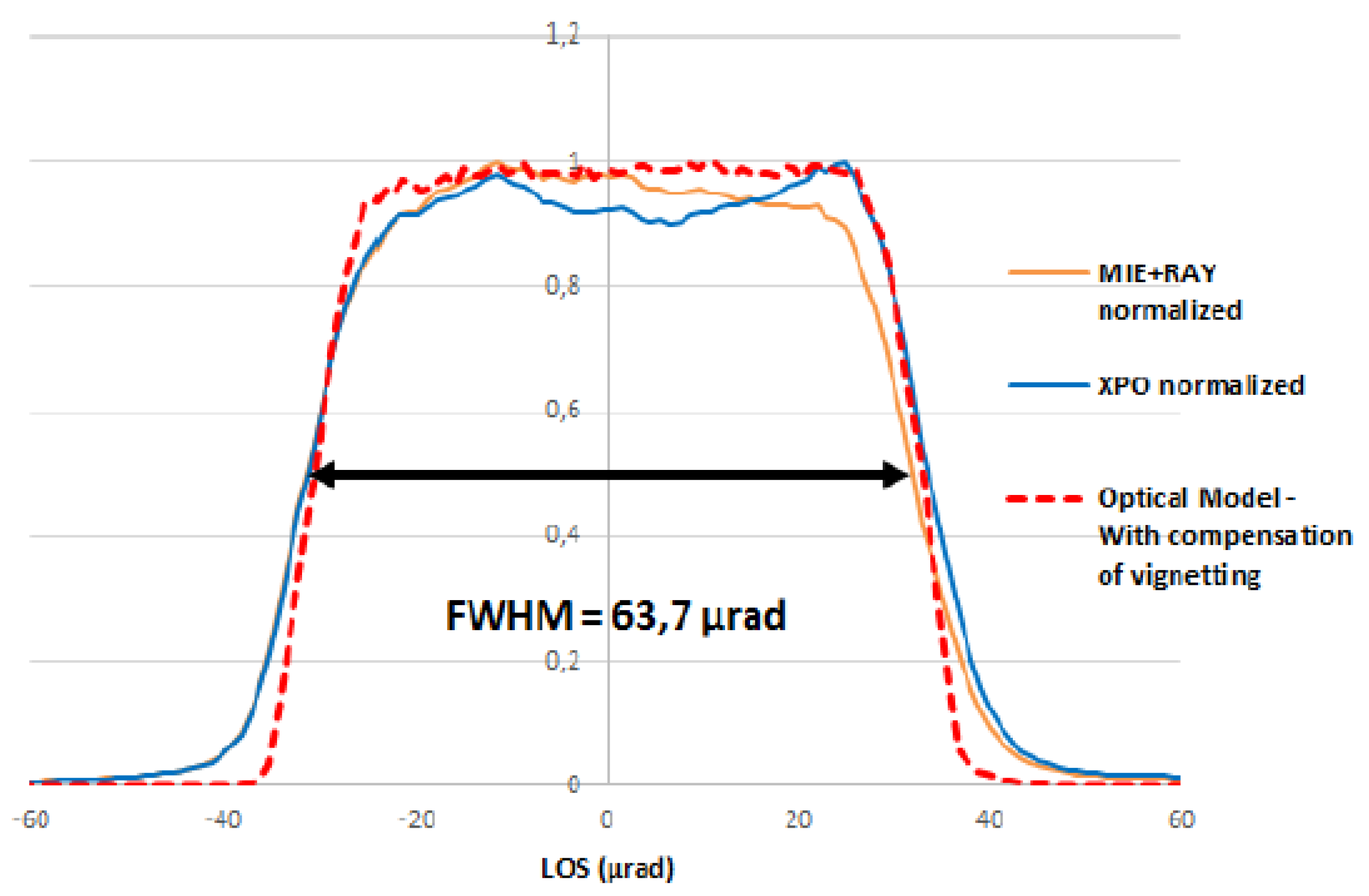


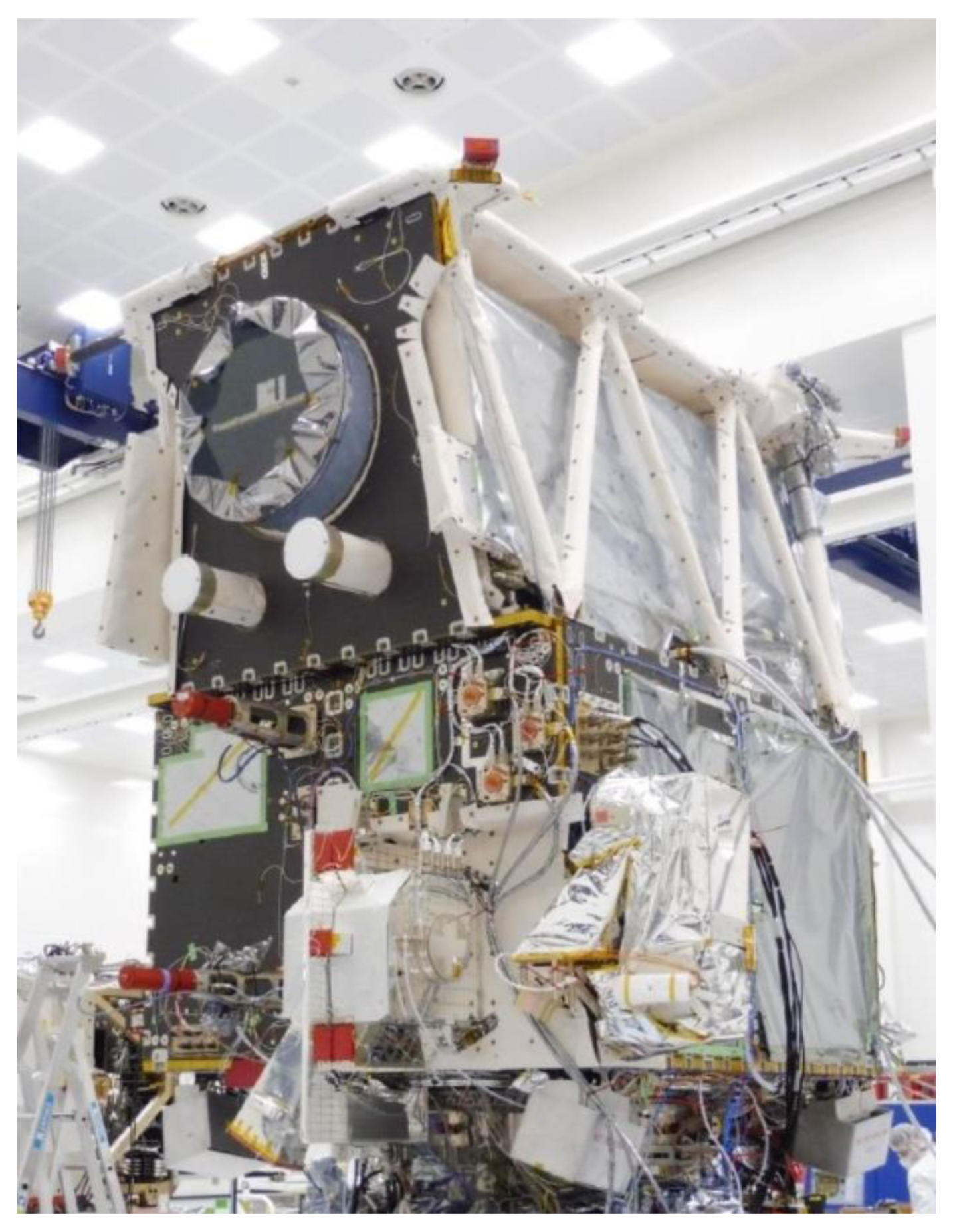
| Radiometric Characteristics | ATLID | Unit |
|---|---|---|
| Receiver field of view | 66.5 1 | µrad |
| Telescope diameter | 620 | mm |
| Solar background filter equivalent bandwidth | 710 | pm |
| Mie Co Polar transmission EOL 2 | 45 | % |
| Mie Cross Polar transmission EOL 2 | 43 | % |
| Rayleigh transmission EOL 2 | 43 | % |
| (molecular to molecular channel 3) C_mm | 75 | % |
| (molecular to particle channel 3) C_mp | 25 | % |
| (particular to molecular channel 3) C_pm | 16 | % |
| (particular to particular channel 3) C_pp | 84 | % |
| Laser pulse energy | 35 | mJ |
| Pulse repetition frequency | 51 | Hz |
| Transmitter field of view | 36 | µrad |
| Transmitter EOL transmission | 89 | % |
| Transmitter polarisation | Linear | - |
| Detection Performance | ATLID | Unit |
|---|---|---|
| Vertical resolution from 0 to 20 km | 100 | m |
| Vertical resolution from 20 km to 40 km | 500 | m |
| Vertical cross talk | 4.5% on 500 m, 11% on 100 m | |
| Computed quantum efficiency | 79/75/79 1 | % |
| Linearity | <+/−1 2 <+/−2 3 | % |
| Noise worst case | 2.2 | e- rms |
| Dynamic margin on channel vs. predicted worst signal | 18/5/12 1 | % |
| LIDAR Absolute Backscatter Retrieval Accuracy 10 km Horizontal Integration | Typical BOL | Worst Case EOL | Unit |
|---|---|---|---|
| Mie Co Polar on sub visible cirrus: β = 8 × 10−7 sr−1 m−1 | 31 | 48 | % |
| Mie Co Polar on thin cirrus: β = 1.4 × 10−5 sr−1 m−1 | 6 | 8 | % |
| Mie Cross polar on depol. cirrus: β = 2.6 × 10−6 sr−1 m−1 | 19 | 23 | % |
| Rayleigh (above cirrus 10 km) | 12 | 17 | % |
Publisher’s Note: MDPI stays neutral with regard to jurisdictional claims in published maps and institutional affiliations. |
© 2021 by the authors. Licensee MDPI, Basel, Switzerland. This article is an open access article distributed under the terms and conditions of the Creative Commons Attribution (CC BY) license (http://creativecommons.org/licenses/by/4.0/).
Share and Cite
do Carmo, J.P.; de Villele, G.; Wallace, K.; Lefebvre, A.; Ghose, K.; Kanitz, T.; Chassat, F.; Corselle, B.; Belhadj, T.; Bravetti, P. ATmospheric LIDar (ATLID): Pre-Launch Testing and Calibration of the European Space Agency Instrument That Will Measure Aerosols and Thin Clouds in the Atmosphere. Atmosphere 2021, 12, 76. https://doi.org/10.3390/atmos12010076
do Carmo JP, de Villele G, Wallace K, Lefebvre A, Ghose K, Kanitz T, Chassat F, Corselle B, Belhadj T, Bravetti P. ATmospheric LIDar (ATLID): Pre-Launch Testing and Calibration of the European Space Agency Instrument That Will Measure Aerosols and Thin Clouds in the Atmosphere. Atmosphere. 2021; 12(1):76. https://doi.org/10.3390/atmos12010076
Chicago/Turabian Styledo Carmo, João Pereira, Geraud de Villele, Kotska Wallace, Alain Lefebvre, Kaustav Ghose, Thomas Kanitz, François Chassat, Bertrand Corselle, Thomas Belhadj, and Paolo Bravetti. 2021. "ATmospheric LIDar (ATLID): Pre-Launch Testing and Calibration of the European Space Agency Instrument That Will Measure Aerosols and Thin Clouds in the Atmosphere" Atmosphere 12, no. 1: 76. https://doi.org/10.3390/atmos12010076
APA Styledo Carmo, J. P., de Villele, G., Wallace, K., Lefebvre, A., Ghose, K., Kanitz, T., Chassat, F., Corselle, B., Belhadj, T., & Bravetti, P. (2021). ATmospheric LIDar (ATLID): Pre-Launch Testing and Calibration of the European Space Agency Instrument That Will Measure Aerosols and Thin Clouds in the Atmosphere. Atmosphere, 12(1), 76. https://doi.org/10.3390/atmos12010076




